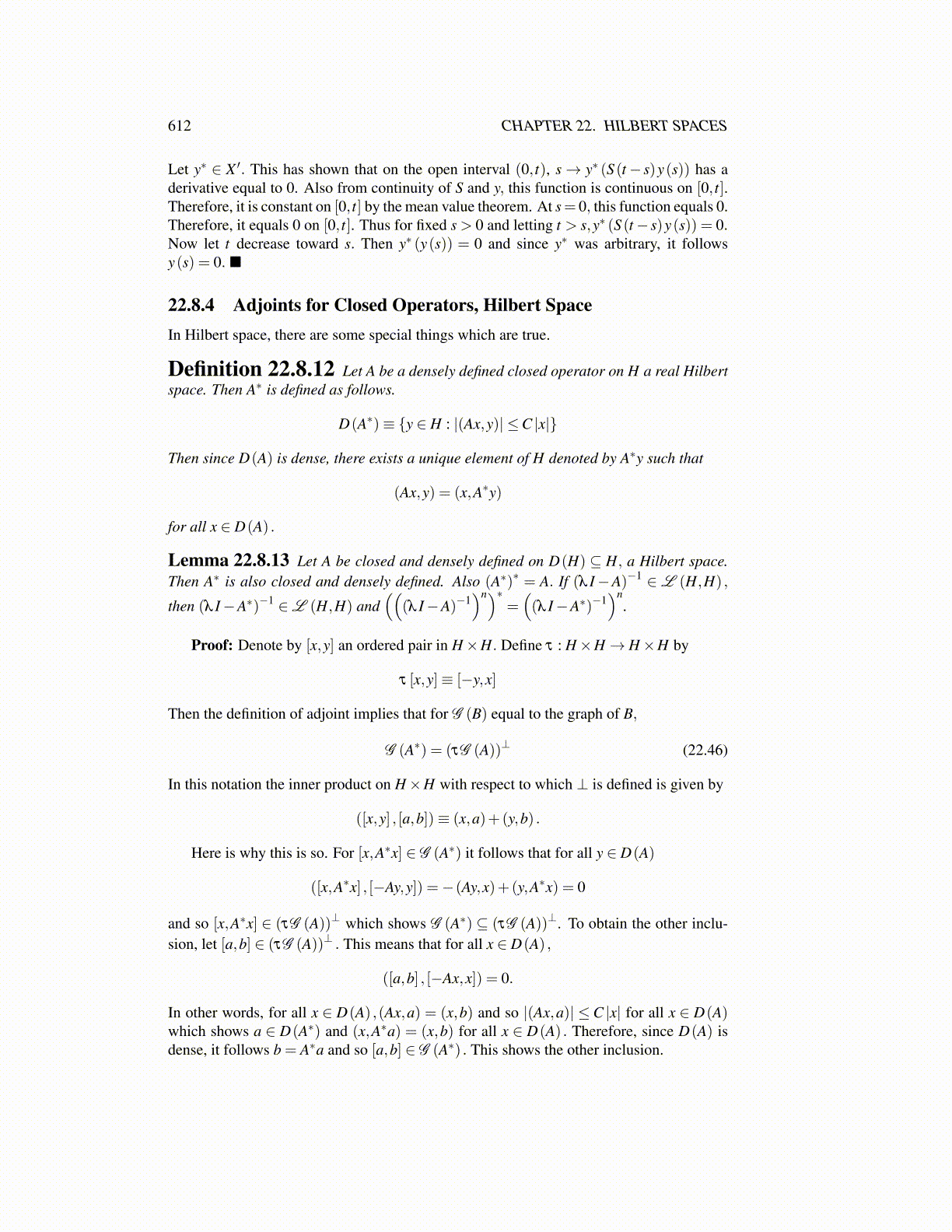
612 CHAPTER 22. HILBERT SPACES
Let y∗ ∈ X ′. This has shown that on the open interval (0, t), s→ y∗ (S (t− s)y(s)) has aderivative equal to 0. Also from continuity of S and y, this function is continuous on [0, t].Therefore, it is constant on [0, t] by the mean value theorem. At s= 0, this function equals 0.Therefore, it equals 0 on [0, t]. Thus for fixed s > 0 and letting t > s,y∗ (S (t− s)y(s)) = 0.Now let t decrease toward s. Then y∗ (y(s)) = 0 and since y∗ was arbitrary, it followsy(s) = 0. ■
22.8.4 Adjoints for Closed Operators, Hilbert SpaceIn Hilbert space, there are some special things which are true.
Definition 22.8.12 Let A be a densely defined closed operator on H a real Hilbertspace. Then A∗ is defined as follows.
D(A∗)≡ {y ∈ H : |(Ax,y)| ≤C |x|}
Then since D(A) is dense, there exists a unique element of H denoted by A∗y such that
(Ax,y) = (x,A∗y)
for all x ∈ D(A) .
Lemma 22.8.13 Let A be closed and densely defined on D(H) ⊆ H, a Hilbert space.Then A∗ is also closed and densely defined. Also (A∗)∗ = A. If (λ I−A)−1 ∈ L (H,H) ,
then (λ I−A∗)−1 ∈L (H,H) and((
(λ I−A)−1)n)∗
=((λ I−A∗)−1
)n.
Proof: Denote by [x,y] an ordered pair in H×H. Define τ : H×H→ H×H by
τ [x,y]≡ [−y,x]
Then the definition of adjoint implies that for G (B) equal to the graph of B,
G (A∗) = (τG (A))⊥ (22.46)
In this notation the inner product on H×H with respect to which ⊥ is defined is given by
([x,y] , [a,b])≡ (x,a)+(y,b) .
Here is why this is so. For [x,A∗x] ∈ G (A∗) it follows that for all y ∈ D(A)
([x,A∗x] , [−Ay,y]) =−(Ay,x)+(y,A∗x) = 0
and so [x,A∗x] ∈ (τG (A))⊥ which shows G (A∗) ⊆ (τG (A))⊥. To obtain the other inclu-sion, let [a,b] ∈ (τG (A))⊥ . This means that for all x ∈ D(A) ,
([a,b] , [−Ax,x]) = 0.
In other words, for all x ∈ D(A) ,(Ax,a) = (x,b) and so |(Ax,a)| ≤C |x| for all x ∈ D(A)which shows a ∈ D(A∗) and (x,A∗a) = (x,b) for all x ∈ D(A) . Therefore, since D(A) isdense, it follows b = A∗a and so [a,b] ∈ G (A∗) . This shows the other inclusion.